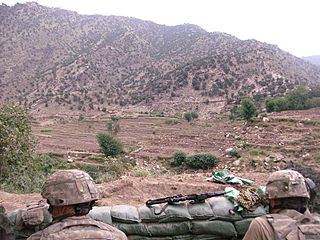
Operation Anaconda or the Battle of Shah-i-Kot was a military operation that took place in early March 2002 as part of the War in Afghanistan. CIA paramilitary officers, working with their allies, attempted to destroy al-Qaeda and Taliban forces. The operation took place in the Shah-i-Kot Valley and Arma Mountains southeast of Zormat. This operation was the first large-scale battle in the post-2001 War in Afghanistan since the Battle of Tora Bora in December 2001. This was the first operation in the Afghanistan theater to involve a large number of U.S. forces participating in direct combat activities.

Insurgency weapons and tactics (IWAT) are weapons and tactics, most often involving firearms or explosive devices, intended for use by insurgents to engage in guerrilla warfare against an occupier, or for use by rebels against an established government. One type of insurgency weapon are "homemade" firearms made by non-professionals, such as the Błyskawica (Lightning) submachine gun produced in underground workshops by the Polish resistance movement. Another weapon that is part of the conventional military arsenal, but which has been taken up to great effect by insurgents, is the RPG. Two examples of an improvised weapon used by insurgents would be the improvised explosive devices used in Iraq and the Molotov cocktails used against vehicles and tanks. Two tactics used by many insurgents are assassinations and suicide bomb attacks. The latter tactic is used when an insurgent has a bomb strapped to them or in their car, which provides a low-tech way for insurgents to get explosives close to critical enemy targets.

The Taliban insurgency began after the group's fall from power during the 2001 War in Afghanistan. The Taliban forces fought against the Afghan government, led by President Hamid Karzai, and later by President Ashraf Ghani, and against a US-led coalition of forces that has included all members of NATO; the 2021 Taliban offensive resulted in the collapse of the government of Ashraf Ghani. The private sector in Pakistan extends financial aid to the Taliban, contributing to their financial sustenance.

Forward Operating Base Salerno is a former forward operating base used by the United States Armed Forces from 2002 to 2013 during Operation Enduring Freedom. It is located in the southeastern province of Khost, Afghanistan, near the city of Khost. On 1 November 2013, U.S. forces withdrew from FOB Salerno and transferred control of the installation to the Afghan National Army.
The following lists events that happened during 2004 in Afghanistan.

Operation Jacana is the codename for a series of operations carried out by coalition forces in Afghanistan. The operations were carried out most notably by 45 Commando Royal Marines. U.S. forces, Australian SAS and Norwegian FSK also participated. The operation was a follow-up operation of Operation Anaconda and was meant to kill or capture the remaining Al-Qaida and Taliban rebels. The operation has been called a "mopping up" operation after Operation Anaconda. The operation is named after an African bird type, jacana, described in one manual as "shy, retiring, easily overlooked".

The Helmand province campaign was a series of military operations conducted by the International Security Assistance Force (ISAF) forces against Taliban insurgents and other local groups in the Helmand Province of Afghanistan. Their objective was to control a province that was known to be a Taliban stronghold, and a center of opium production. None of the ISAF's intended strategic and political objectives were achieved in the long term.

The Battle of Wanat took place on July 13, 2008, when around 200 Taliban insurgents attacked American troops stationed near Quam, in the Waygal district of Afghanistan's far eastern Nuristan province. The distant position was primarily defended by United States Army soldiers with 2nd Platoon, Chosen Company, 2nd Battalion, 503rd Infantry Regiment (Airborne), 173rd Airborne Brigade Combat Team.

The Battle of Shewan was a military engagement between Coalition forces and Taliban insurgents that took place on August 8, 2008, near the village of Shewan in the Bala Buluk district, Farah Province, Afghanistan.

The siege of Musa Qala took place between July 17 and September 12, 2006 in Afghanistan's Helmand province. A small force of International Security Assistance Force (ISAF) troops and Afghan security forces were besieged by Taliban insurgents inside the district centre of Musa Qala.

The following addresses the events in Northern Afghanistan between April 2009 and 2014. While this part of the country had long been relatively peaceful compared to the all-out war zones of the south and east, tensions would flare up again in 2008 when the German soldiers deployed to the area came under attack more often, leading to the deaths of the several soldiers. Previously hindered by national caveats, the deteroriating security situation prompted the German-led Regional Command North to launch a series of operations to take on the rising insurgency. Concerted operations began after an insurgent attack on PRT Kunduz within minutes of German Chancellor Angela Merkel's departure from a visit. Within two years, the German presence would be doubled and additional reinforcements from the American ISAF contingent were called in, including heavy German armoured vehicles and US aviation assets, allowing for a more aggressive approach towards the insurgency.
The Battle of Dahaneh took place in the town of Dahaneh, Helmand Province, and its surrounding areas as part of the Afghanistan War. It began when U.S. and Afghan troops launched an Operation to capture the town from the Taliban, in the Helmand Province of Southern Afghanistan. Coalition troops met heavy resistance, and believe the Taliban were forewarned of the incoming attack, though they were successful in securing Dahaneh.

The Battle of Kamdesh took place during the war in Afghanistan. It occurred on October 3, 2009, when a force of 300 Taliban assaulted the American Combat Outpost ("COP") Keating near the town of Kamdesh in Nuristan Province in eastern Afghanistan. The attack was the bloodiest battle for US forces since the Battle of Wanat in July 2008, which occurred 20 miles (32 km) away from Kamdesh. The attack on COP Keating resulted in 8 Americans killed and 27 wounded while the Taliban suffered 150-200 killed.
The following lists events that happened during 2006 in Afghanistan.
On January 24, 2002, the American military launched an overnight raid against a "large munitions cache" north of Kandahar, as part of its invasion of Afghanistan, claiming that it was a weapons stockpile of the Taliban or al-Qaeda. However, it was later discovered that the target was a compound that the United States had asked to collect weapons for the government of Hamid Karzai, and that the dead and captured were all backers of the American invasion.
The following lists events that happened during 2015 in Afghanistan.
The following lists events that happened during 2016 in Afghanistan.
Events in the year 2017 in Afghanistan.

The Ghazni offensive began on 10 August 2018, when Taliban fighters launched an assault on the city of Ghazni, Afghanistan's sixth largest city and one which has been culturally and strategically important for much of the country's history. The attack resulted in the deaths of hundreds of insurgents, soldiers, police, and civilians. The city also sustained large-scale property damage. The battle, occurring only weeks before Afghanistan's 2018 parliamentary election, was the largest since a three-day truce in June had raised hopes of peace talks.











